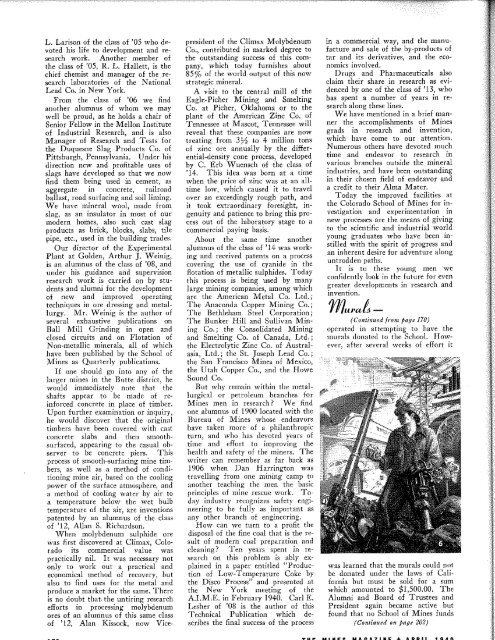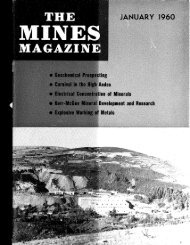A L U M N I N U M B C E L E B R A T I N G ... - Mines Magazine
A L U M N I N U M B C E L E B R A T I N G ... - Mines Magazine
A L U M N I N U M B C E L E B R A T I N G ... - Mines Magazine
Create successful ePaper yourself
Turn your PDF publications into a flip-book with our unique Google optimized e-Paper software.
L. Larison of the class of '05 who devotedhis life to development and researchwork. Another member ofthe class of '05, R. L. liallett, is thechief chemist and manager of the researchlaboratories of the NationalLead Co. in New York.From the class of '06 we findanother alumnus of whom we maywell be proud, as he holds a chair ofSenior Fellow in the Mellon Instituteof Industrial Research, and is alsoManager of Research and Tests forthe Duquesne Slag Products Co. ofPittsburgh, Pennsylvania. Under hisdirection new and profitable uses ofslags have developed so that we nowfind them being used in cement, asaggregate in concrete, railroadballast, road surfacing and soil liming.We have mineral wool, made fromslag, as an insulator in most of ourmodern homes, also such cast slagproducts as brick, blocks, slabs, tilepipe, etc., used in the building trades.Our director of the ExperimentalPlant at Golden, Arthur J. Weinig,is an alumnus of the class of '08, andunder his guidance and supervisionresearch work is carried on by studentsand alumni for the developmentof new and improved operatingtechniques in ore dressing and metallurgy.Mr. Weinig is the author ofseveral exhaustive publications onBall Mill Grinding in open andclosed circuits and on Flotation ofNon-metallic minerals, all of whichhave been published by the School of<strong>Mines</strong> as Quarterly publications.If one sbould go into any of thelarger mines in the Butte district, hewould immediately note that theshafts appear to be made of reinforcedconcrete in place of timber.Upon further examination or inquiry,he would discover that the originaltimbers have been covered with castconcrete slabs and then smoothsurfaced,appearing to the casual observerto be concrete piers. Thisprocess of smooth-surfacing mine timbers,as well as a method of conditioningmine air, based on the coolingpower of the surface atmosphere, anda method of cooling water by air toa temperature below the wet bulbtemperature of the air, are inventionspatented hy an alumnus of the classof '12, Allan S. Richardson.When molybdenum sulphide orewas first discovered at Climax, Coloradoits commercial value waspractically nil. It was necessary notonly to work out a practical andeconomical method of recovery, butalso to find uses for the metal andproduce a market for the same. Thereis no doubt that the untiring researcheiforts in processing molybdenumores of an alumnus of this same classof '12, Alan Kissock, now Vicepresidentof the Climax MolybdenumCo., contributed in marked degree tothe outstanding success of this company,which today furnishes about85% of the world output of this nowstrategic mineral.A visit to the central mill of theEagle-Picher Mining and SmeltingCo. at Picher, Oklahoma or to theplant of the American Zinc Co. ofTennessee at Mascot, Tennessee willreveal that these companies are nowtreating from to 4 million tonsof zinc ore annually by the differential-densitycone process, developedby C. Erb Wuensch of the class of'14. This idea was born at a timewhen the price of zinc was at an alltimelow, which caused it to travelover an exceedingly rough path, andit took extraordinary foresight, ingenuityand patience to bring tliis processout of the laboratory stage to acommercial paying basis.About the same time anotheralumnus of the class of '14 was workingand received patents on a processcovering the use of cyanide in theflotation of metallic sulphides. Todaytbis process is being used by manylarge mining companies, among whichare the American Metal Co. Ltd.;The Anaconda Copper Mining Co. ;The Bethleham Steel Corporation;The Bunker Hill and Sullivan MiningCo.; tbe Consolidated Miningand Smelting Co. of Canada, Ltd.;the Electrolytic Zinc Co. of Australasia,Ltd.; the St. Joseph Lead Co.;the San Francisco <strong>Mines</strong> of Mexico,the Utah Copper Co., and the HoweSound Co.But why remain within the metallurgicalor petroleum branches for<strong>Mines</strong> men in research? We findone alumnus of 1900 located with theBureau of <strong>Mines</strong> whose endeavorshave taken more of a philanthropicturn, and who has devoted years oftime and effort to improving thehealth and safety of the miners. Thewriter can remember as far back as1906 when Dan Harrington wastravelling from one mining camp toanother teaching tbe men the basicprinciples of mine rescue work. Todayindustry recognizes safety engineeringto be fully as important asany other branch of engineering.How can we turn to a profit thedisposal of the fine coal that is the resultof modern coal preparation andcleaning? Ten years spent in researchon this problem is ably explainedin a paper entitled "Produc-, tion of Low-Temperature Coke bythe Disco Process" and presented atthe New York meeting of theA.I.M.E. in February 1940. Carl E.Lesher of '08 is the author of thisTechnical Publication which describesthe final success of the processin a commercial way, and the manufactureand sale of the by-products oftar and its derivatives, and the economicsinvolved.Drugs and Pharmaceuticals alsoclaim their share in research as evidencedby one of the class of '13, whohas spent a number of years in researchalong these lines.We have mentioned in a brief mannerthe accomplishments of <strong>Mines</strong>grads in research and invention,which have come to our attention.Numerous others have devoted muchtime and endeavor to research invarious branches outside the mineralindustries, and have been outstandingin their chosen field of endeavor anda credit to their Alma Mater.Today the improved facilities atthe Colorado School of <strong>Mines</strong> for investigationand experimentation innew processes are the means of givingto the scientific and industrial worldyoung graduates who have been instilledwith the spirit of progress andan inherent desire for adventure alonguntrodden paths.It is to these young men weconfidently look in the future for evengreater developments in research andinvention.(Continued from page 170)Operated in attempting to have themurals donated to the School.However,after several weeks of effort itwas learned that the murals could notbe donated under the laws of Californiabut must be sold for a sumwhich amounted to $1,500.00. TheAlumni and Board of Trustees andPresident again became active butfound tbat no School of <strong>Mines</strong> funds(Continued on page 202)THE MINES MAGAZINE -t- APRIL 1940177

















